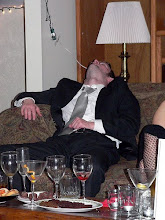 |
| fig. 1: COMPUTERS |
The first was, of course, Moore's age. He was fifty-seven at the time of filming View, and felt squicked out over being paired with twenty-nine-year-old Tanya Roberts, almost thirty years his junior. Moore had been rumored to depart the series as early as 1981's For Your Eyes Only, but eventually came back for two more installments. The violence in this film was also a tremendous turn-off for Moore. The accelerated bloodshed of 1980's action movies, which would overwhelm Bond completely in 89's Licence to Kill, first rears its head here in a scene where Major Antagonist Max Zorin and his henchlady May Day gun down dozens of mine workers.
As baroque plans to destroy the world go, this one's pretty baroque. A View to A Kill follows James Bond from recovered microchip to race horse tampering to a plot to blow up the San Andreas fault. The plot plays less like a linear progression and more like a word association game. Bond recovers a microchip that can withstand an electromagnetic pulse, which leads him to Christopher Walken's Max Zorin, and a subplot involving horse racing and whether or not Zorin is using steroids on his horses. He's not, he's controlling them with microchips--somehow--but the emphasis on breeding and technology is an interesting one.
Ever since the eponymous Dr No, James Bond has been dealing with the strange. It's part of the trappings of his genre. Spy fiction grew out of adventure fiction, and these films owe a great deal more to the latter tradition than to the procedural nuts an bolts of, say, a John Le Carre novel, or The Americans. It's unlikely the character would have endured in anything like the same way if he had been grounded more in reality.
What Zorin and Dr No and Jaws represent--and what later on Gustav Graves will represent--is a particular strain of transhumanism, especially as tied to cybernetics. James Bond's role, as ever, is as the reactionary, to keep the status quo, in this case the status quo of the human race, intact. Zorin is the product of Nazi experiments to produce a superior human through chemistry. No and Jaws are cyborgs. Graves is a sort of post-racial designer human, able to assume the identity that best suited his plans. Both previous Moore-Bond villains Stromberg and Drax hinge their own plans on fomenting a war between East and West and then escaping (to the Sea, and to Space, respectively) to create Utopian societies out of the ashes of that conflict. And Bond, that old stick-in-the-mud, can't have that.
Zorin's objectives aren't quite so pie-in-the-sky. He's out to make money, to corner the microchip market, and if that means blowing up San Francisco, well, omelettes and eggs. He's stopped by Bond in the requisite climactic fight, and whatever anxieties the present day of 1985 has about computers and cybernetics are put to rest. It's almost a ritual, these things. Zorin is sacrificed in the same way Elliot Carver and Franz Sanchez will be, as effigies for our cultural unease.
 |
| fig. 2: Too Old For This Shit |




No comments:
Post a Comment